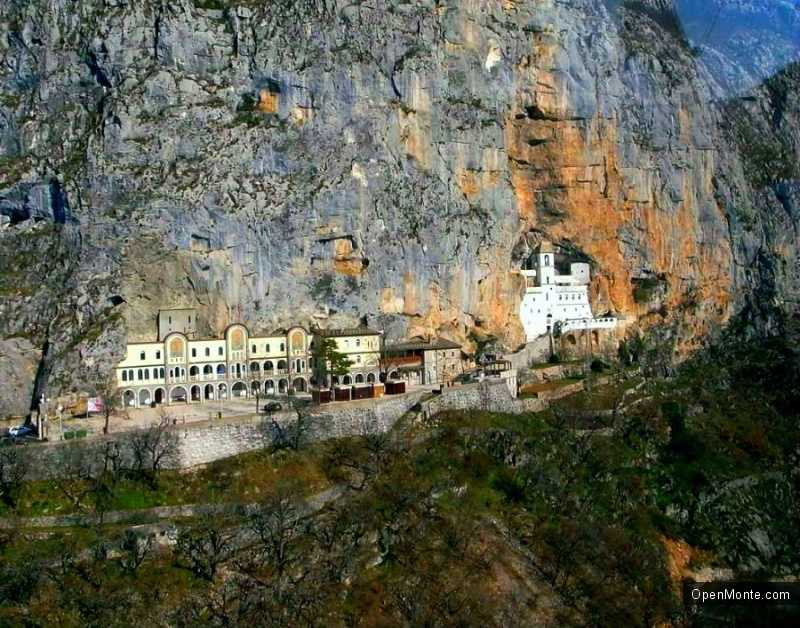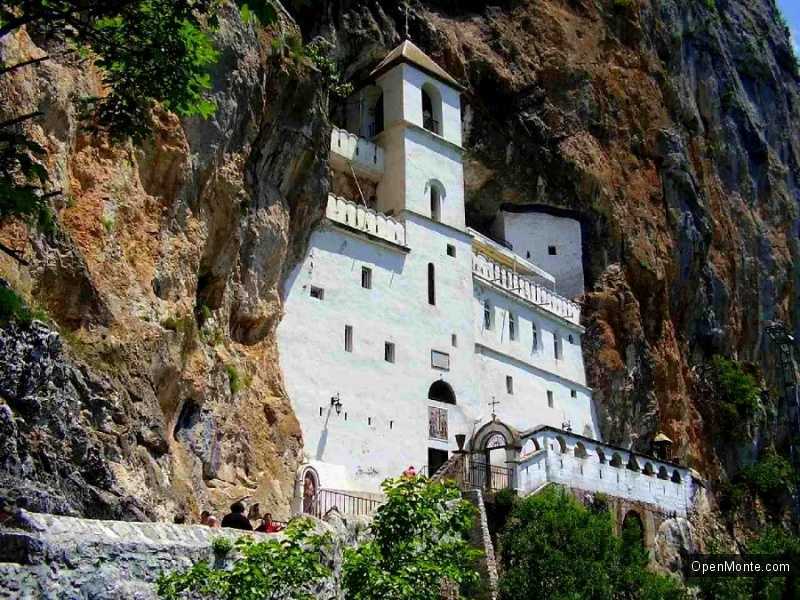St. Basil, Ostrog Wonderworker, founded Ostrog Monastery in Montenegro in the middle of the XVII century. The incorruptible relics of the founder to this day are kept in the monastery and many visit them to ask for healing from diseases.
The monastery was named after the mountain range on which it was built. The word “ostrog” itself goes back to the Old Slavonic language, where it meant “fortification, fortified place”.
From the height of the Ostrog Monastery you can see wonderful views of the mountains and the nearby valley.
The road to the monastery
The famous Ostrog Monastery is located on the territory between Danilovgrad and Niksic (Ostrog monastery on the map). It can be seen from a distance on the right side of the road, if you are driving from the side of Danilovgrad. In order to find the monastery, you need to turn right, which is indicated by a large sign, and then the country road almost immediately doubles.

Kiosks with souvenirs, food and all sorts of things for tourists, as well as restaurants and cafes will help you to choose the direction — they are just on the way to the monastery, don’t be mistaken!
The road to Ostrog Monastery is quite narrow, so there are certain rules.
First of all, those who drive from the outside of the road (i.e. closer to the edge of the abyss) are let through. If you’re driving on the inside of the road, you’re the one who’s going to drive back to let the other car pass by.

Second of all, if you are met by a bus and you are not the driver of another bus, you are giving way in any case.
Finally, be careful, but do not be nervous, because according to the legend, Saint Basil of Ostrog guards this road, so there have been no accidents so far.

History and structure of the Ostrog Monastery
The complex includes two monasteries: Upper (Gornji) and Lower (Donji), built at different times. The Upper Monastery consists of two temples. The oldest temple is dedicated to the Presentation of the Blessed Virgin Mary, and was probably created before the Saint Basil of Ostrog came there.
The central temple is dedicated to the Feast of the Cross. The date of foundation of the Upper Monastery is considered to be 1665. Six years later — May 12, 1671 — Saint Basil himself was buried here. Since then, this day is considered a holiday. Every year on May 12 people flock to the Ostrog Monastery to honor the memory of the saint and worship the relics.

The lower monastery was created by Archimandrite Joseph Pavichevich in 1820 with the blessing of Saint Peter of Cetinje. This monastery is dedicated to the Holy Trinity. Not far from the Lower Monastery once was the Church of St. George.
According to the church-people legend, it was built at the end of XIII — beginning of XIV centuries. Several times it was destroyed during the Turkish rule, but each time it was restored.
Judging by archaeological excavations, the church was last destroyed in 1895 and after that, it was not restored. Now the remains of its walls can be found next to the old monastery cemetery.

The newest church in the monastery complex is the Church of St. Martyr Stanko, created at the end of 2004 on a hill above the Lower Monastery. In this church there are the incorruptible hands of the Martyr Stanko, who, as a shepherd from a village near Danilovgrad, refused to accept Islam and was killed by the Turks on September 15, 1712.
His hands have remained intact to this day. In the temple, 27 people who defended Ostrog from the Communist army in October 1943, were also reburied.
Not far from the Lower Monastery in the town of Brina there are also old guest rooms. Until 1977, the monastery school was located there, and in 1994 the building was re-consecrated and opened to the public.
The sanctuary acquired its modern appearance in the 1920s, when it was restored after a fire that destroyed most of the complex.

How to get to the monastery?
Most pilgrims tend to go straight to the Upper Monastery, which is reached by a five-kilometer road winding between trees.
You can also use the short walkway, which has many visitors in the summer. Before climbing, be sure to stock up on water and save time for periodic rest, so as not to get tired on the way to the temples of the Upper Monastery.
Inside the cave with the relics of St. Basil of Ostrog, believers whisper their requests to the Saint very quickly and leave notes with wishes: there are so many people who want to get in that a huge queue constantly pushes through and pilgrims have to leave as soon as possible.
If you want to have a good look around without encountering other believers, come here from the end of September until the beginning of June.
Pearls of the monastery
On the territory of the Ostrog Monastery in Montenegro, there is a healing spring from which water is poured into bottles and distributed free of charge to all pilgrims. To get this water, go to the monastery shop.
Remember that everyone is entitled to one bottle. If you are not given water, you can remind yourself of this. The bottle will have the Upper Monastery and the Orthodox Cross stamps on it, and it can also become a wonderful souvenir.
Monks tell about many miracles that have happened here over the centuries. For example, the relics of St. Basil are still miraculously preserved — no matter what happens, they always managed to hide them. It is said that during the Second World War, when the Ostrog Monastery in Montenegro was under fire, a shell flew inside the monastery, but it did not explode, just split into two parts. To this day, the cracked shell lies in one of the vestry to confirm the miracle.
For Orthodox Montenegro, the Ostrog Monastery plays an important role. Many claim that the Orthodox faith in the country was preserved because of it. Now 12 monks live in the monastery permanently. Every year the Ostrog Monastery in Montenegro receives tens of thousands of believers!

Full of impressions from visiting Ostrog, many people decide to go to other monasteries of Montenegro: to the monastery of Morača, Cetinje, Dajbabe, and others.





